The best tank of World War II! Slayer of tigers and panthers! The only winner of this war! Historians and enthusiasts of weapons stubbornly describe the Soviet T-34 in superlatives. Completely wrong.
When in June 1941 Germany attacked the USSR, information began to flow from the front about the emergence of new types of Soviet tanks, resistant to the anti-tank weapons used by the Wehrmacht at that time. This was somewhat of a surprise to the German command, the more so as intelligence information did not confirm the fact that the Soviet Union owned such vehicles. As you can easily guess, these were medium tanks of the T-34 type as well as the heavy KW-1 and KW-2 tanks.
Tank T-34
At first glance, it was impressive:a diesel engine, angled armor plates increasing the resistance of the structure to penetration by a bullet, wide tracks favoring mobility and a 76 mm caliber gun. The Germans did not have similar tanks at that time and it seemed that the Red Army was light years ahead of the Wehrmacht in the field of armored weapons.
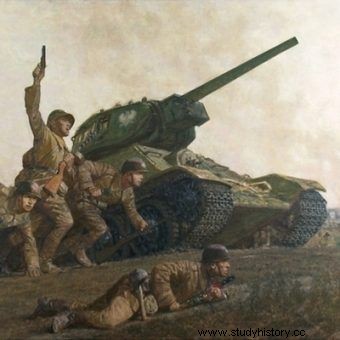
Meanwhile, the T-34 had a lot of shortcomings. During the prototype tests, the failures of the drive system were particularly noticeable. The engine's service life, i.e. its guaranteed trouble-free and safe operation time, is set at only 100 hours. The clutches had poor durability. Gearbox teeth broken. Despite all these shortcomings, on March 31, 1940, it was decided to put it into production with virtually no corrections. Oh, a legendary Russian fantasy!
Hitler's tank - Stalin's tank. Comparison straight from Top Gear
The Russians learned about the dubious quality of their new tank in the summer of 1940, when it was compared with the PzKpfw III purchased in Germany. It was a real shock for them when it turned out that, with the exception of a larger gun caliber and slightly better armor, the Soviet tank was second to the German "three" in almost every respect.
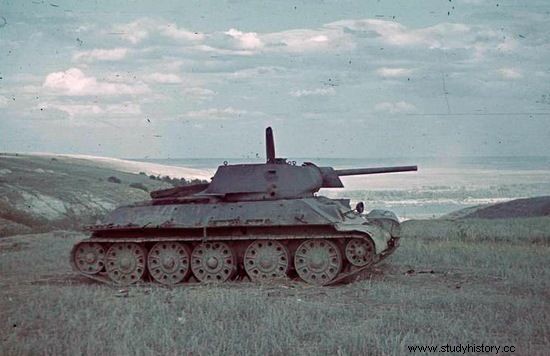
On paper, the T-34 tank looked great. During the tests, it turned out that it had many flaws that caused many problems for the crews (photo Bundesarchiv; lic. CC ASA 3.0).
During road tests, the T-34 tank achieved a lower top speed:48.2 km / h compared to 68.1 km / h PzKpfw III. The suspension of the Soviet tank also left a lot to be desired. In terrain, the T-34 swayed strongly from side to side, and on unevenness it had a tendency to vibrate. The German tank was more comfortable in this respect and at the same time much quieter than its Soviet counterpart.
When it comes to the propulsion system, the T-34 tank differed significantly from the PzKpfw III. The German tank had a much more reliable and trouble-free engine. Air filters were the Achilles' heel of the Soviet engine. They had to be cleaned every few dozen kilometers, otherwise the drive unit would seize.
Tower like a gas chamber
The working environment of the four-person crew of the Soviet tank was also not very friendly. The loader and the commander could hardly fit in the cramped tower. The latter also had to act as a gunner, which made him overburdened with duties. Observation and sighting devices were of low quality. A single large hatch led to the inside of the tower with hinges misplaced at the front.
Especially, as Kacper Śledziński emphasizes in his book Tankiści. The true story of the four panzer ":
The commander's turret was missing for circular observation. The commander had to use a periscope to distort the perspective. The opening of the enormous heavy plate of the hatch blocked the view. They managed to straddle the tower.
The problem of the discharge of gunpowder gases while firing guns or machine guns was poorly solved. The tower had no fan, only a vent. As a result, after a few shots, its interior was filled with carbon monoxide with a concentration ten times higher than the legal limit.
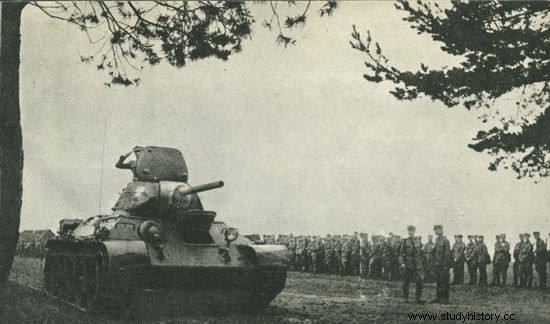
Apart from the emergency engines and gearboxes, the tight turret, which could hardly contain the loader and the commander, was a big problem. In addition, there was a very bulky hatch leading to it.
In practice, in order to ventilate the tank, both the turret hatch and the front mechanic-driver hatch had to be opened. The latter, despite the perfectly shaped front plate of the tank, was also its weak point. In the event of an enemy missile hitting it, it would fall into the interior of the car, "incidentally" massacring the driver sitting behind it.
Two are better than one
Driving the tank itself was a real burden for the driver due to the hard and imprecise gearbox. It was a very physically exhausting job. It took a lot of luck and patience to put it in gear. Often it was necessary to use the help of a radiotelegraph shooter sitting next to it. As Hans Halberstadt, an American combat vehicle expert stated after the T-34 ride, the ideal tank driver would be a guy who looked like a bloated weightlifter.
The equipment with means of communication was tragic. Less than one in ten tanks had a radio. Signal flags were in common use. The extension telephone only connected the commander and the driver. The rest of the crew lived in "ignorance" of the tactical situation.
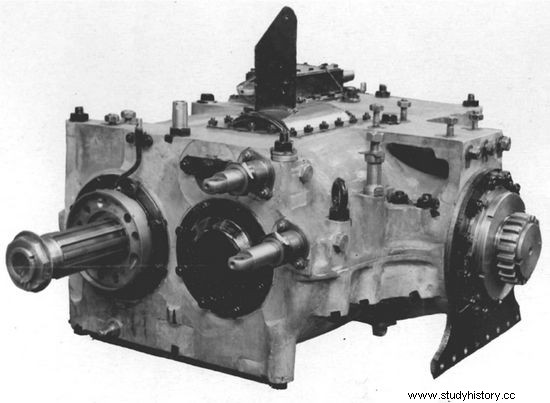
The real bane of the T-34 driver was the hard and imprecise gearbox. Often, the help of a shooter-radiotelegraphist sitting next to the driver was needed to shift the gear to the right.
No wonder that after these compromising tests for the T-34, there were voices among Soviet decision-makers about the need to discontinue the production that had just started. It was suggested either to thoroughly rebuild the tank or replace it with a new one. It was even proposed to resume production of its predecessor, the BT-7M. In the end, it was decided to continue production, and in October 1940, design works on its successor began. However, all these plans were interrupted by the outbreak of the war.
Tactics as simple as building a flail
There were approximately 900 T-34s in the western part of the USSR at that time. Theoretically, with a larger gun and stronger armor than the enemy's vehicles, they constituted a lot of power that could determine the outcome of the campaign. It should also be remembered that even the worst tank, with the use of appropriate tactics and with a well-trained crew, can be a formidable weapon.
Meanwhile, the crews of the Soviet tanks were horribly untrained. The basic specialist course lasted only 72 hours. The tactics of the armored units of the Red Army were characterized by total chaos. Individual groups of tanks attacked in waves, one after the other, disregarding losses until they succeeded.
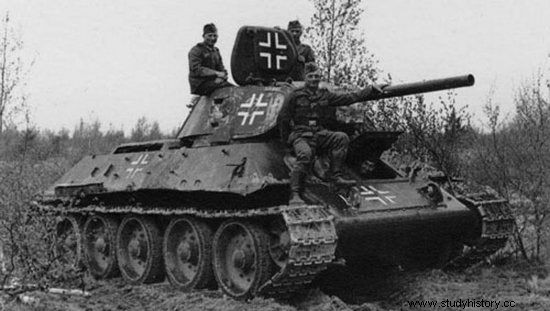
In 1941, the Soviets lost the most machines not in combat, but due to breakdowns and lack of fuel. Tanks like the T-34 in the photo, often after minor adjustments, were later transferred to German armored units.
The lack of radio stations meant that the crews did not react to the dynamically developing situation on the battlefield. They followed a plan agreed in advance and were beyond any control during the fight. In the hustle and bustle of battle, they often lost their orientation in the field and wandered around the battlefield, because maps were usually only owned by senior commanders and only they could read them. The Germans skillfully used this mess. It was enough that they separated the Soviet tanks from the infantry supporting them, and massacred both of them separately.
Another thing is that most of the T-34s were lost not in combat, but in retreat:due to gearbox failures, engines seizure or a prosaic lack of fuel.
Tank T-34-85 - another pride of the "red tankers"
Paradoxically, the T-34 had the greatest advantage over the German tanks, but only in some respects, at the beginning of the war, when the Red Army suffered one defeat after another. Of course, during the war it was constantly modernized. Its last version was the T-34-85 tank, the first examples of which left the factory halls in December 1943.
The basic change was to increase the gun's caliber. A thicker and longer barrel improved the range and accuracy of the shot as well as the strength and effectiveness of armor penetration. In addition, there was room for the fifth crew member in the tower. In the new tank, the commander could only focus on fighting. The gunner and the gunner were responsible for destroying the targets. (quoted after:Kacper Śledziński, "Tankiści. The true story of the four tankers").
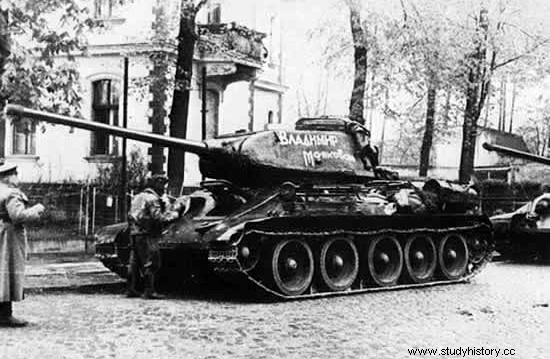
Although the T-34s were inferior to German tanks in many respects, so many were produced that in the end their simple design proved to be the key to victory. The photo shows the T-34 with a caliber of 85 mm.
However, it happened when the German Panthers and Tigers were already in service, which clearly outclassed him in terms of firepower and armor. Even later versions of the PzKpfw IV became an equal opponent for him. The anti-tank weapons of the German infantry did not have any problems with destroying them.
"Ford T" of the Soviet armored forces
In one respect, it was definitely unrivaled. During World War II, Soviet factories left over 53,000. these tanks. No other cars were produced more. The time of making one machine in the hottest period of the war decreased from 8 thousand. man-hours in 1941 up to 3.7 thousand in 1943. The quality of these cars must have been terrible. However, with such a mass of tanks, even the primitive Soviet tactics had to pay off. The Russians were building more T-34s than the Germans were able to destroy them.
For comparison, the Panthers, which were also not completely perfect, were produced in total less than 5,000. The most widely used by the Wehrmacht PzKpfw IV of all versions - about 8.5 thousand. and the most dangerous tank of World War II, the Tiger - 1,355 (plus 487 copies of the Royal Tiger). The construction of one Tiger consumed as much as 300 thousand. man-hours, i.e. 81 Soviet tanks could be produced at the same time! This time simplicity won over refinement.
